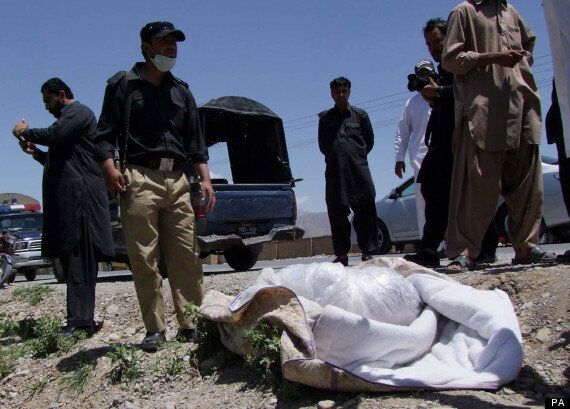Why do terrorists group behead? “Simply to create terror,” says Adrian Levy, the award-winning journalist and author, whose latest book The Meadow: Kashmir 1995 – Where the Terror Began, charts the true story of a brutal kidnapping in the mountains of Kashmir that, for him, marked "the beginning of modern terrorism".
Written with Cathy Scott Clark, the tome recalls the disappearance of six Western backpackers in the mid-nineties, one of whom, Hans Christian Ostrø, was beheaded by his abductors. The Norwegian’s body was dumped near Pahalgam, Kashmir, and scarred with the name of the terror organisation responsible. Of the six, only one escaped. The remaining four have never been found.
This beheading 17 years ago, so Levy argues, was “carried out to capture the world’s attention”. The terror group, Al-Faran, had demanded the release of Pakistani militant Maulana Masood Azhar, who was imprisoned in India.
Despite please from international organisations, the release was not forthcoming.
“Beheading the Norwegian was an act exploring how the West would respond,” says Levy, since when the practice has become an all too familiar feature in the terrorists' lexicon. Daniel Pearl's murder in 2002 was just one of many such incidents in Pakistan's recent history.
Over the weekend, the body of Khalil Dale, a British aid worker who was abducted in Baluchistan province, Pakistan, in January, was found on the outskirts of the town of Quetta. He had been beheaded. A note was attached to his corpse saying that he was killed because no ransom was paid to his captors. According to local police, the abduction and execution had all the hallmarks of the Taliban.

The towns along the border form part of a large, disenfranchised area
“Beheading is just part of the grammar in this modern epoch of terror,” says Levy. Reflecting on this most recently atrocity, he adds: “Anyone that tells you it is an Islamic act would be incorrect. That would be a misunderstanding of what is an act of terror and an act of religion.”
I ask the journalist, who has spent several years investigating these all too frequent acts of brutality on the Pakistan-Afghanistan border, about the motivations behind kidnapping and beheading, and its relations to the Taliban.
“The killing of Dale was a horrific crime, a senseless crime,” he says, “but there is a common mistake that creeps into the reporting of some of these acts - there is no such thing as 'the Taliban' in the sole sense of an al-Qaeda operated Taliban.
“There are a lot of criminal gangs, many that are simply mercantile. Dale’s death may have nothing to do with what the Afghan [the more religiously motivated] Taliban.”
For Levy, “Taliban” has become a catchall term used in the region, often by the criminal gangs themselves as a defensive measure. "What they're really interested in is leveraging money out of the increasingly profitable trade in kidnapping," he says.
“Some of that money does go into the terrorist funding engine,” he admits, “but a lot of it is just about enriching the clans behind the gangs.”
The 46-year-old foreign correspondent, who has been working for the Guardian since 2001, adds that “scores of these gangs” operate in the border region that runs along the demarcation line between Pakistan and Afghanistan. For them kidnap and ransom is a favoured methodology.
“It is important to remember that a lot of the victims of kidnapping are not reported in Western media. They are quite often wealthy Pakistanis, many of whom are still missing or are still being held.”
So lucrative has kidnapping become in Pakistan that the practice has started spreading south towards the financial centre of Karachi and the political centre of Islamabad.
Yet it is the towns along the border, such as Quetta - part of a large, disenfranchised area - that remain the most dangerous.
“The region has been allowed to become a poor and unruly place,” says Levy.
“This was a strategic move by the Pakistan military, who wanted to create a ‘prickly hedge’, an area that was impossible for foreigners to penetrate or to invade; an area that could act as a buffer between Pakistan and Afghanistan.”
Another problem, he says, is that the Pakistani border regions do not form a homogenous state. “It’s a borderland blending between two countries, full of tribes who operate and wander quite freely. No country would be able to rule an area effectively. Pakistan has occasionally been accused of deliberately misruling the area so that it can carry out its more covert foreign policy, but also with the current destabilised civilian government it’s incapable of governing the area. “

Pakistani security officials stand next to covered body of Khalil Dale
“There are elements of the Afghan Taliban working in the area,” he adds “but more familiar are groups and tribes from Pakistan to give succour to the Afghan Taliban.”
For Levy, some of these so-called “Taliban” groups operating in Pakistan do have religiously motivated goals, such as the introduction of Islamic Sharia in the areas such as the Swat Valley. However, many of the “Taliban” groups working in the Waziristan area are “simply criminal”, out to “exact revenge for the poverty they themselves live in”.
Regardless of the motivations, the incidents of kidnapping are “very frequent”, says Levy. “They are happening all the time”.
“Some of the most affected parties are the emigrated children of Pakistani families – British, American and European Pakistanis - people that are born elsewhere but return to see their ancestral roots and are almost immediately targeted."
“They’ll get off the plane, drive in the family car up to Peshawar, and will often end up being abducted as they are viewed as foreign and rich - people from whom the abductors can extract money from their families.”
Levy adds that the police rarely get involved, and the sums involved can be massive, running into millions of dollars.
The author believes that the group that kidnapped Dale was “particularly mercantile, particularly vicious and acting in a very tribal way”.
“Whatever the ridiculous justifications they invent, this was simply a profiteering scheme,” he says. “Yes - they could also have killed him if they feared a rescue effort… but the brutality of the crime - it’s the act of people with a criminal mindset rather than a religious or a political one.”
Visit Adrian Levy and Cathy Scott Clark's website here.
